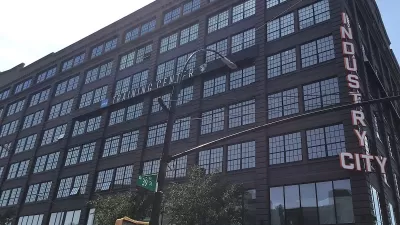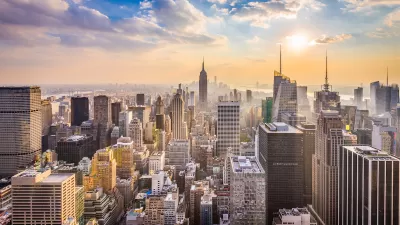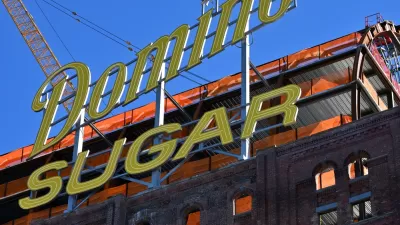80 Flatbush, a major high-rise development combining apartments, offices, and community amenities, lies at the center of ongoing debate between YIMBYs and neighborhood character advocates.

New York City development debates have come to a head this spring around a 986-foot-tall mixed-use tower complex to be sited between downtown Brooklyn and Boerum Hill. Joe Anuta writes, "arguments in favor of respecting the low-rise environment are colliding into a central tenet of the city's planning strategy: build housing near public transit. In this case, there are few mass-transit hubs in the city more vital and connected than the Atlantic Avenue–Barclays Center station a block away."
The project's critics expected a more modest form of development on the site. "Opponents of Alloy's project have said that the site—a trapezoidal block between Flatbush and Third avenues and State and Schermerhorn streets—was mapped within the footprint of the Boerum Hill Association and envisioned as a medium-density buffer around the skyscrapers farther north." Those skyscrapers already include the 1,066-foot-tall 9 DeKalb Avenue, currently under construction.
In early May, Brooklyn Community Board 2 voiced its opposition to the proposed rezoning in a resounding vote, as Norman Oder reports in an in-depth look at the issue. That vote was an advisory one, and the debate continues. Oder writes, "it's unclear how much the vote will influence Borough President Eric Adams, whose recommendation is also advisory but represents a broader constituency, and Council Member Stephen Levin (District 33), who holds the key voice on the City Council."
FULL STORY: Developer attempts to push the limits on border of brownstone Brooklyn

Study: Maui’s Plan to Convert Vacation Rentals to Long-Term Housing Could Cause Nearly $1 Billion Economic Loss
The plan would reduce visitor accommodation by 25% resulting in 1,900 jobs lost.

Alabama: Trump Terminates Settlements for Black Communities Harmed By Raw Sewage
Trump deemed the landmark civil rights agreement “illegal DEI and environmental justice policy.”

Why Should We Subsidize Public Transportation?
Many public transit agencies face financial stress due to rising costs, declining fare revenue, and declining subsidies. Transit advocates must provide a strong business case for increasing public transit funding.

Paris Bike Boom Leads to Steep Drop in Air Pollution
The French city’s air quality has improved dramatically in the past 20 years, coinciding with a growth in cycling.

Why Housing Costs More to Build in California Than in Texas
Hard costs like labor and materials combined with ‘soft’ costs such as permitting make building in the San Francisco Bay Area almost three times as costly as in Texas cities.

San Diego County Sees a Rise in Urban Coyotes
San Diego County experiences a rise in urban coyotes, as sightings become prevalent throughout its urban neighbourhoods and surrounding areas.
Urban Design for Planners 1: Software Tools
This six-course series explores essential urban design concepts using open source software and equips planners with the tools they need to participate fully in the urban design process.
Planning for Universal Design
Learn the tools for implementing Universal Design in planning regulations.
Smith Gee Studio
Alamo Area Metropolitan Planning Organization
City of Santa Clarita
Institute for Housing and Urban Development Studies (IHS)
City of Grandview
Harvard GSD Executive Education
Toledo-Lucas County Plan Commissions
Salt Lake City
NYU Wagner Graduate School of Public Service





























